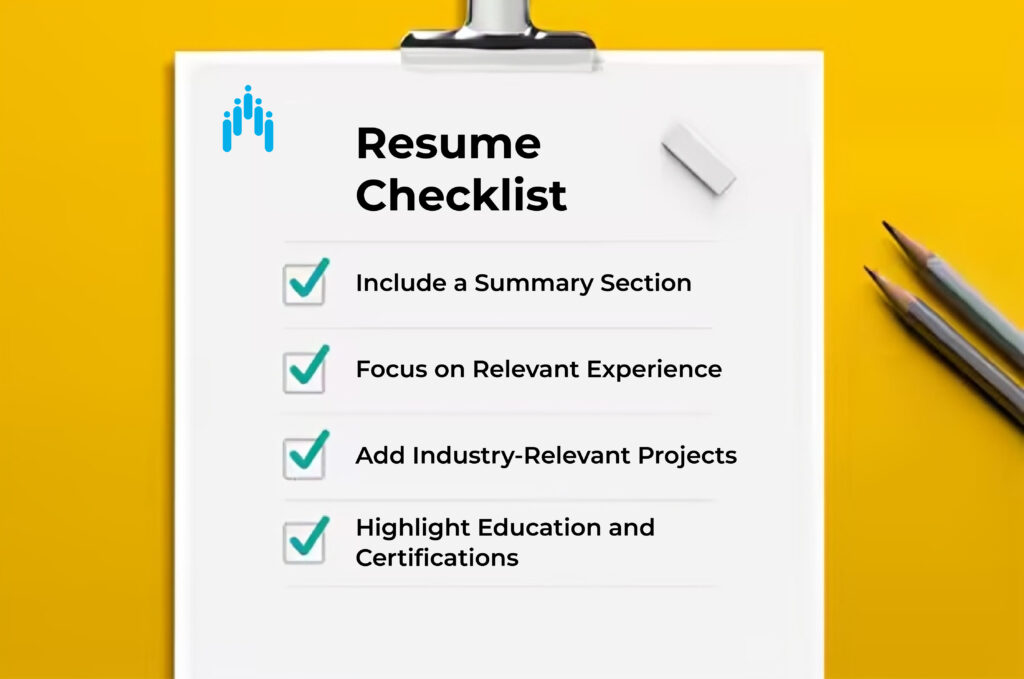Data Science Resume – General Guidelines
Creating a standout data scientist resume is critical to get noticed in today’s competitive market. However, many candidates struggle to present their skills and experiences effectively, resulting in rejection.
This blog highlights key guidelines for creating a successful data science resume, outlines common mistakes made by IT professionals transitioning to data science and offers actionable strategies to enhance your chances of getting shortlisted. By focusing on relevant experiences, highlighting essential skills and structuring your CV effectively, you can stand out in the competitive data science job market.
How to write a strong Data Science Resume?
When creating a data scientist resume, it’s important to present your information in a clear, concise and professional manner. Here are some tips:
1) Use a Professional and Simple Design:
Stick to a simple design with no more than 2 or 3 colors. Include a professional photo but avoid clutter. Your data science resume should have a clean, organized layout to make it easy to read.
2) Proofread for Spelling & Grammar Errors:
Small errors can undermine your credibility. Always proofread to ensure your data science resume is free of spelling and grammatical mistakes.
3) Skip the Career Objective:
Hiring managers are more interested in your data science skills and experiences than a generic career objective. Instead, provide a concise summary that highlights your expertise in data science.
4) List Experience & Education in Reverse Chronological Order:
List your most recent experience and education first. This allows hiring managers to quickly see your latest achievements, which are usually the most relevant.
5) Quantify Your Achievements:
Instead of vague descriptions, use numbers to highlight impact. For instance, instead of “Worked on building a classification model,” say “Delivered a classification model that saved $10 million annually.” Quantifying your accomplishments makes them more impactful.
6) Keep It Concise:
Aim for a 1-page data science resume unless you have extensive experience that cannot be condensed. Brevity is key—ensure that every word adds value.
With these basics in place, let’s address some common mistakes IT professionals make when transitioning to a data science role and how to avoid them.
Common Data Science Resume Mistakes Made by IT Professionals while transitioning to Data Science
In my experience reviewing over 100 data scientist resumes in the past few years, I have identified several recurring challenges faced by IT professionals looking to transition into data science roles. Understanding these common pitfalls is crucial for enhancing your chances of being shortlisted.
In this section, we will outline these issues and provide actionable solutions to help you present your data science resume effectively and highlight your relevant experience.
1) Overemphasizing Irrelevant IT Experience:
A common mistake is that more than half of the resume focuses on IT experience that’s not relevant to data science. This information is often listed at the top, which can confuse or lose the interest of hiring managers.
2) Missing a Summary Section:
Many candidates skip the summary section. This is a missed opportunity to provide a quick overview of your data science capabilities, relevant skills and certifications.
3) Including Irrelevant Projects:
Including open-source projects that are not aligned with the job you are applying for is another mistake. Focus on projects that showcase skills pertinent to the data science role.
Recognizing these errors is the first step. Now, let’s explore actionable ways to enhance your data science resume and increase your chances of getting shortlisted.
How to Improve Your Data Science Resume and Get Shortlisted?
To stand out in the competitive data science job market, it’s crucial to highlight the right experiences and skills. Here’s how you can do that:
1) Add a Strong Summary Section:
Start your data science resume with a summary that highlights your overall profile, emphasizing data science skills like Python, SQL, data engineering and any relevant education or certifications. This helps hiring managers quickly understand your background and qualifications.
2) Focus on Relevant Experience:
Ensure that your data science resume focuses on relevant experience such as data analysis, programming in Python, R or SQL and stakeholder management. Clearly show how your work had a business impact, whether through increased efficiency or cost savings.
3) Include Industry-Relevant Projects:
Include open-source or industry projects that are directly related to the data science role you are applying for. Highlight a variety of problem statements to show your versatility and ability to solve different kinds of business problems.
4) Highlight Education and Certifications:
Ensure your data science education and certifications are prominently featured. Hiring managers want to see that you have formal training in the field, so don’t hide this information.

Hiring managers are under pressure to find the right candidates quickly. By presenting your data science qualifications and relevant experience clearly, you help make their decision easier—and that increases your chances of landing an interview. Once you are shortlisted, you have already made it into the top 10% of candidates.
Data Science Resume Checklist for Job Applications
Recruiters spend only a few seconds scanning resumes. Use this checklist to ensure your data scientist resume is optimized:
- Professional and clean design with proper formatting
- No grammar or spelling mistakes
- A compelling summary showcasing data science expertise
- Clear and concise work experience with quantifiable achievements
- Relevant data science projects that demonstrate real-world applications
- Well-organized education and certifications
By following these steps, you’ll make it easier for hiring managers to see your value and relevant experience. With a well-structured and targeted CV, you’ll not only stand out but also increase your chances of being shortlisted.
Conclusion
Crafting a standout data science resume requires attention to detail, a focus on relevant skills and the ability to present your experience in a way that speaks to the needs of hiring managers. By avoiding common mistakes, emphasizing your achievements and structuring your data science resume for clarity, you can significantly increase your chances of being shortlisted for an interview.
If you are looking to further enhance your chances of landing your dream data science role, preparation is key. Check out our Interview Preparation Program designed specifically to help you succeed in data science interviews. Master the skills and techniques needed to confidently showcase your expertise and secure the job.
FAQs
A good data science resume should have a clean design with 2-3 colors, a professional photo, no spelling or grammatical errors, relevant experience listed in reverse chronological order, quantifiable achievements and ideally be limited to one page.
A career objective often takes up valuable space and doesn’t provide as much value as showcasing your relevant skills and experiences. Instead, focus on demonstrating your qualifications and accomplishments.
When describing your past work, use specific metrics to illustrate your impact. For example, instead of stating “Worked on building a classification model,” say “Delivered a classification model that resulted in a cost saving of $10 million per year.”
Common mistakes include emphasizing irrelevant experience, not including a summary section and listing irrelevant open-source projects. These pitfalls can dilute the effectiveness of your CV.
Your summary should provide a brief overview of your profile, highlighting relevant skills, certifications and experiences related to data science. This helps hiring managers quickly understand your suitability for the role.
It’s crucial to focus on relevant experience related to data engineering, SQL, data analysis and programming languages like Python and R. Highlighting this experience emphasizes your preparedness for the data science role.
Include industry-relevant projects, particularly those that demonstrate your skills in solving real-world data problems. Ensure these projects align with the job you’re applying for to show your capabilities.
Tailor your data science resume to the specific data science role, focusing on relevant experiences and skills. Use clear, quantifiable achievements and maintain a professional format to grab the attention of hiring managers.
List your education and certifications in a dedicated section, starting with the most recent. Include the degree or certification title, institution name and graduation or completion date. This structure makes it easy for hiring managers to assess your qualifications at a glance.
By following the guidelines outlined in the blog—such as crafting a focused data science ressume, highlighting relevant experience and skills and quantifying achievements—you can significantly enhance your chances of standing out to hiring managers and securing an interview.



